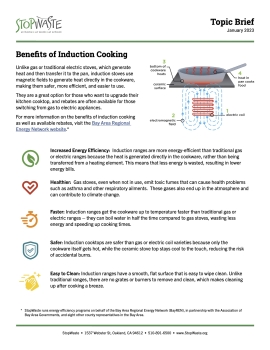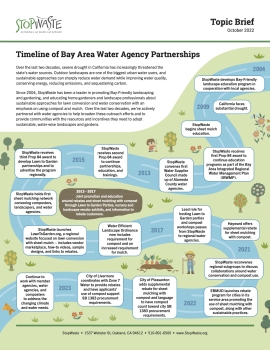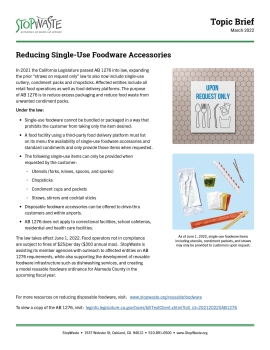You are here
Monthly Topic Briefs
Updates on current issues and projects.

Despite the decreasing amount of food sent to the landfill, wasted food is still one of the largest components of the waste stream. In addition to harmful greenhouse gases released when food decomposes in a landfill, all the resources that went into producing that food are also wasted, depleting finite resources and further contributing to climate change.

Unlike gas or traditional electric stoves, which generate heat and then transfer it to the pan, induction stoves use magnetic fields to generate heat directly in the cookware, making them safer, more efficient, and easier to use.

California’s schools produce over half a million tons of waste each year, with much of this waste coming from the cafeteria. While the majority of the waste stream in schools is comprised of organics, the rest is primarily from the single-use trays, disposable plastic utensils, and condiment packets.

From uneaten leftovers to discarded wrapping paper, the holidays come with a lot of waste. In fact, from Thanksgiving to New Year’s, Americans produce 25 percent more waste than average. But with a little planning and intention, we can reduce our footprint while still experiencing the joy of coming together with family and friends.

Over the last two decades, severe drought in California has increasingly threatened the state’s water sources. Outdoor landscapes are one of the biggest urban water users, and sustainable approaches can sharply reduce water demand while improving water quality, conserving energy, reducing emissions, and sequestering carbon.

California has increasingly been setting ambitious targets to reduce greenhouse gas (GHG) emissions and slow climate change. To help the state meet its goals, local jurisdictions have outlined their own commitments to climate action locally in the form of Climate Action Plans (CAPs). Alameda County was one of the first California counties in which all jurisdictions have developed CAPs.

A new State law, SB 54, known as the Plastic Pollution Prevention and Packaging Producer Responsibility Act, sets new goals to reduce plastic packaging and requires that all forms of single-use products be recyclable or compostable by 2032.

This awards program honors Alameda County businesses and institutions whose leadership and continuous efforts to improve environmental performance and business efficiency have achieved outstanding results. Since the inception of the awards program in 2000, well over 100 Alameda County businesses and institutions have been recognized.

StopWaste’s RE:Source Guide is Alameda County’s one-stop shop for answers on what to do with an unwanted item. The Guide provides easy access to information on proper disposal with the goal of maximizing the benefits of compost, reuse, repair and recycling, while minimizing contamination from items going in the wrong bin.

A new California State law, SB 1383, aims to keep food and other compostable materials out of landfills to reduce methane emissions that contribute to climate change. An important requirement of the law is that food generating businesses must recover surplus edible food that would otherwise be disposed of and donate it to feed people.

In 2021 the California Legislature passed AB 1276 into law, expanding the prior “straws on request only” law to also now include single-use cutlery, condiment packs and chopsticks. Affected entities include all retail food operations as well as food delivery platforms. The purpose of AB 1276 is to reduce excess packaging and reduce food waste from unwanted condiment packs.

A new California State law, SB 1383, aims to keep food and plant materials out of landfills to reduce emissions that contribute to climate change (food scraps emit more methane than any other material in the landfill). Under the law residents must properly sort recyclable and compostable materials into the appropriate containers.